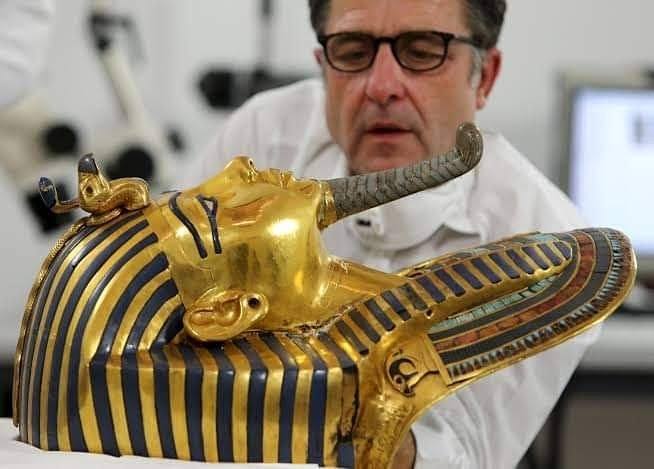A British Egyptologist has uncovered compelling new evidence suggesting that the iconic death mask of King Tutankhamun was not originally crafted for him. Instead, it may have been intended for his stepmother, Queen Nefertiti.
Nicholas Reeves, a distinguished Egyptologist, shared his findings with Egypt’s Ahram Online, stating that the world-famous gold mask of Tutankhamun was never meant for the young pharaoh. Reeves bases his conclusion on a royal cartouche—an official name stamp—found on the mask that appears to have been altered. Beneath the visible inscription, faint traces of an older name remain: Ankhkheprure Nefernefruaten, which translates to Queen Nefertiti.

This revelation challenges long-standing assumptions about the burial artifacts of the boy king. “Blinded by the sheer beauty and immense bullion value of this masterpiece, the world has looked but has completely failed to see the truth—that the gold mask was never meant for Tutankhamun at all,” said Reeves, who previously served as a curator in the Department of Egyptian Antiquities at the British Museum.
Further reinforcing his claim is an often-overlooked detail—the presence of pierced ears on the mask. In ancient Egyptian art, pierced ears were predominantly a feature of queens and children, not adult male pharaohs. This subtle characteristic provides additional support to the theory that the mask was originally designed for a female ruler, further hinting at its intended recipient, Nefertiti.
The remarkable discovery was made possible by an incident involving the mask’s famous beard. In January, a staff member at the Egyptian Museum accidentally broke off the beard and attempted to reattach it hastily, using epoxy glue. The botched repair job sparked outrage and necessitated the mask’s temporary removal from public display for professional restoration. For the first time, the artifact underwent meticulous reexamination, including extensive photography and scientific analysis.
During a fresh examination in Cairo in late September 2015, Reeves made a groundbreaking observation. Beneath the hieroglyphs spelling out Tutankhamun’s personal name, he identified the lightly chased remnants of an earlier, erased royal name. This discovery added weight to the argument that the mask had initially been prepared for another ruler before being repurposed for the young king.
This revelation marks the second time in a year that Reeves has sent shockwaves through the archaeological community. Just months earlier, in October, he had analyzed ultra-high-resolution images of Tutankhamun’s tomb and made another startling claim. Reeves believed he had identified faint traces of painted-over scenes within the burial chamber, which may indicate modifications to the tomb’s original design. Even more significantly, he detected what he suspects to be hidden doorways, which could potentially lead to the final resting place of Queen Nefertiti.
The prospect of such a discovery has captivated both experts and the general public. The Egyptian authorities, recognizing the potential significance of Reeves’ findings, have granted approval for further investigations. A preliminary infrared scan of the tomb’s walls last month yielded promising results, appearing to support Reeves’ claims. In light of this, Egypt’s antiquities officials have authorized the use of ground-penetrating radar to explore the chamber further. If these hidden doors do indeed exist, they could lead to one of the most significant archaeological breakthroughs of the modern era.
Tutankhamun’s tomb, discovered in 1922 by British archaeologist Howard Carter, has long been regarded as one of the greatest finds in Egyptology. The boy king, who ascended the throne at a young age and ruled for roughly a decade, was buried in a remarkably well-preserved tomb filled with exquisite treasures. However, scholars have long debated anomalies in his burial arrangements. The tomb itself is notably smaller than those of other pharaohs, suggesting it may have originally been designed for someone else. The repurposing of burial goods, including the possibility that his famous gold mask was originally meant for Nefertiti, further fuels speculation that Tutankhamun’s burial was arranged hastily after his unexpected death.
Queen Nefertiti remains one of ancient Egypt’s most enigmatic figures. She was the wife of Pharaoh Akhenaten, who is known for attempting to revolutionize Egyptian religion by promoting the worship of a single god, the sun deity Aten. Nefertiti played a significant role in this religious movement and, according to some theories, may have even ruled independently for a time following Akhenaten’s death. However, historical records about her later years and her burial remain scarce, adding to the intrigue surrounding her fate.
Reeves’ hypothesis suggests that after Nefertiti’s reign ended, her burial mask and other funerary items may have been repurposed for Tutankhamun when he died unexpectedly around the age of 18. If a hidden chamber within his tomb does indeed contain her remains, it could provide crucial evidence about her mysterious life and death.
The use of radar technology in Egyptian archaeology has proven successful in the past, uncovering previously hidden structures beneath the sands. If the radar scans confirm the presence of undiscovered chambers within Tutankhamun’s tomb, further excavations could soon follow, potentially leading to one of the most extraordinary discoveries in Egyptology.
While the final proof is yet to be unearthed, Reeves’ research has reignited interest in ancient Egypt’s most famous queen and has prompted a reexamination of long-held assumptions regarding Tutankhamun’s burial. If his findings are validated, they could rewrite a crucial chapter of ancient Egyptian history and offer unprecedented insights into the lives of two of its most legendary rulers.
For now, the world waits in anticipation as archaeologists prepare for the next phase of exploration. The question of whether Nefertiti’s final resting place lies hidden behind the walls of Tutankhamun’s tomb remains unanswered—but if it does, it would be a discovery for the ages.





